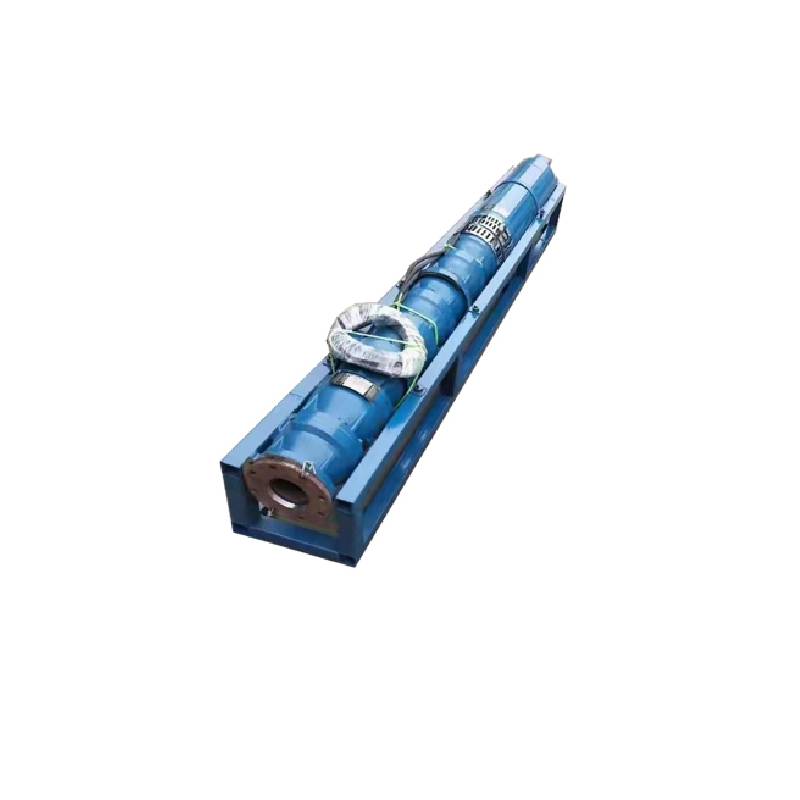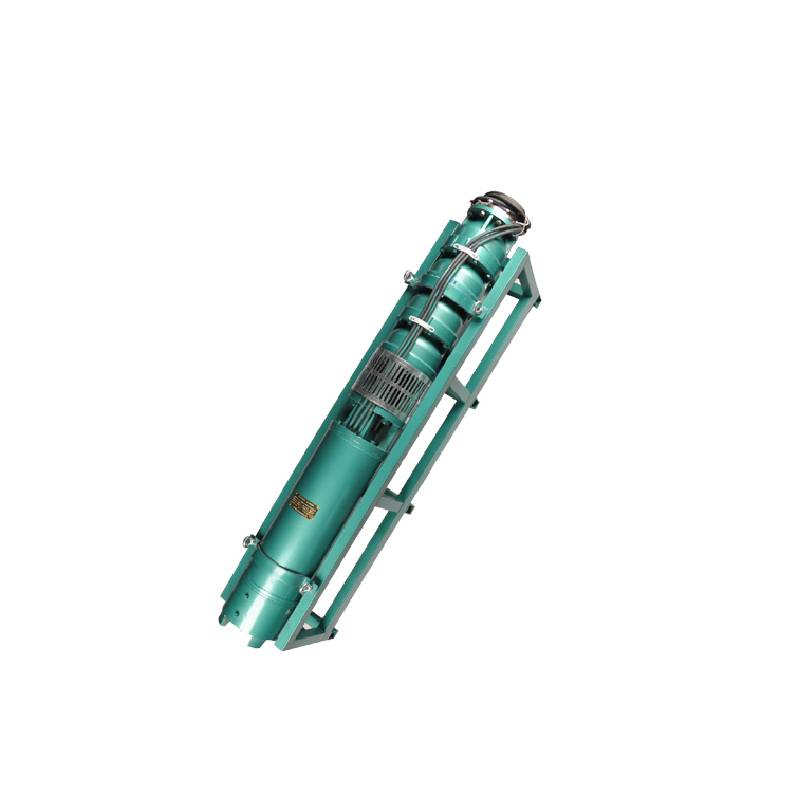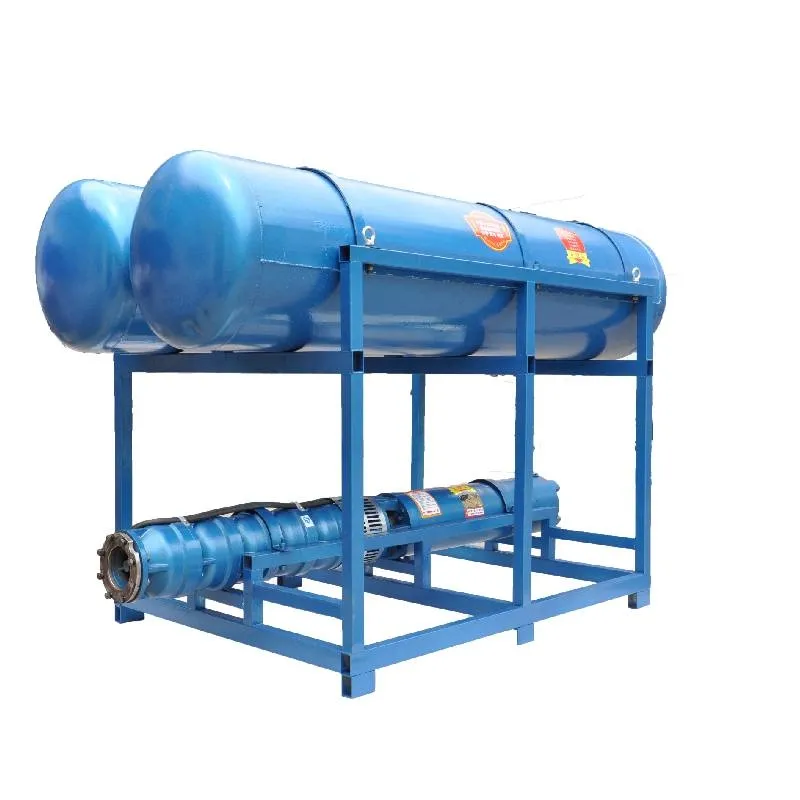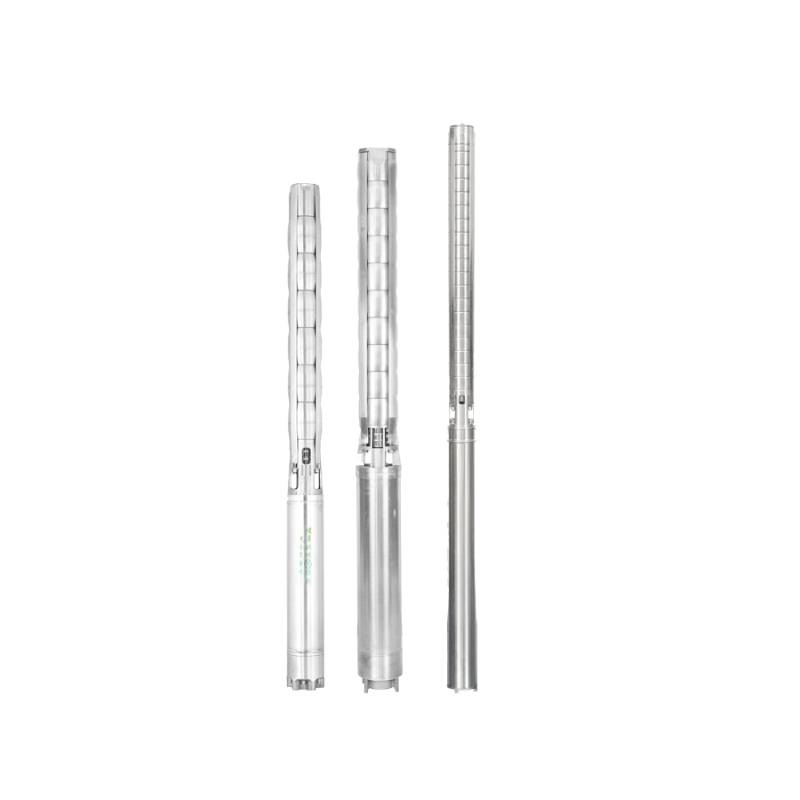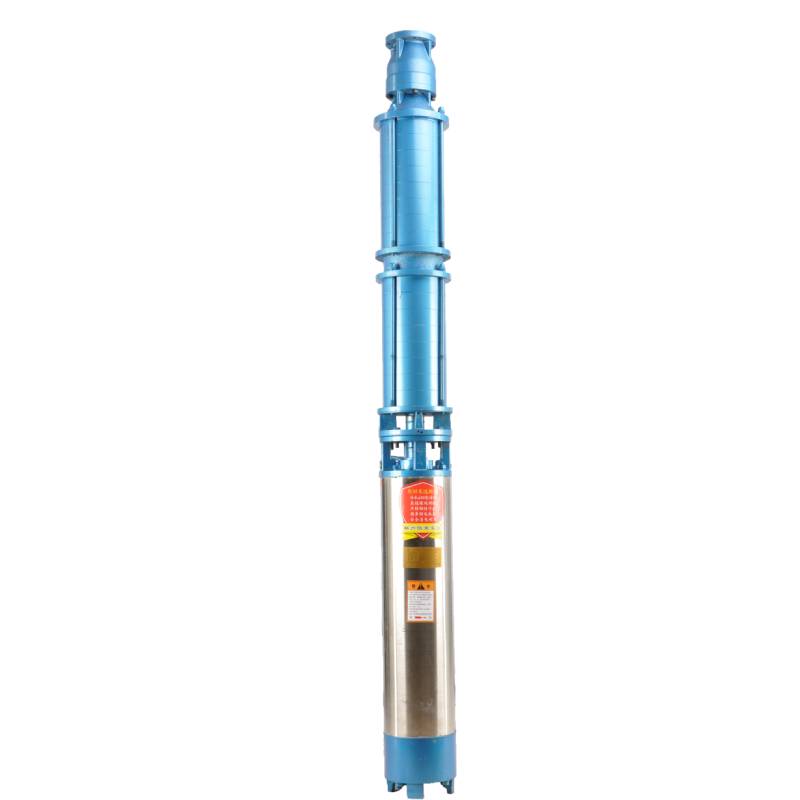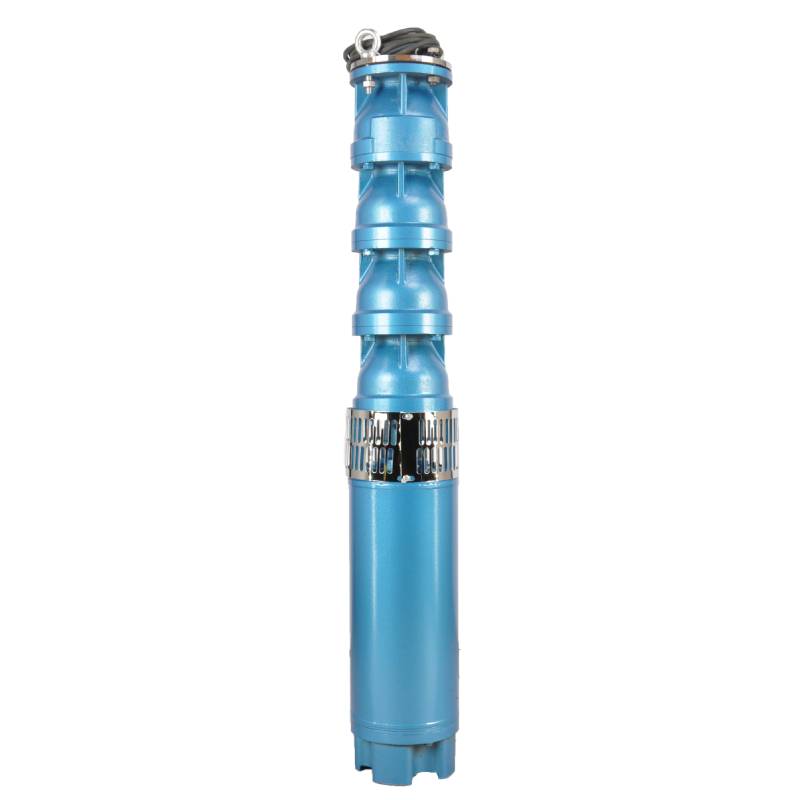This series of fountain pump is a special fountain pump developed by our factory. The pump motor core is made of high quality cold rolled silicon steel, which makes the pump more efficient, has good magnetic conductivity, and does not produce heat when starting frequently. The two ends of the motor rotor are equipped with alloy copper sleeves with water as lubricant. Stainless steel bushings replace ball bearings, avoiding the problems of easy rust of ball bearings and burnout of motor due to lack of oil and wear. Most suitable for music fountain, all models can be used horizontally.
1, alimentazione: trifase CA 380 V (tolleranza +/- 5%), 50 HZ (tolleranza +/- 1%).
2, qualità dell'acqua:
(1) water temperature is not higher than 20 °C;
(2) il contenuto di impurità solide (rapporto di massa) non è superiore allo 0,01%;
(3) Valore del pH (pH) 6,5-8,5;
(4) il contenuto di idrogeno solforato non è superiore a 1,5 mg/l;
(5) il contenuto di ioni cloruro non è superiore a 400 mg/l.
3, il motore è chiuso o ha una struttura bagnata piena d'acqua, prima dell'uso la cavità del motore sommergibile deve essere piena di acqua pulita, per evitare un falso pieno, quindi serrare l'iniezione d'acqua, i bulloni di rilascio dell'aria, altrimenti non è consentito l'uso
4, la pompa sommergibile deve essere completamente immersa nell'acqua, la profondità di immersione non è superiore a 70 m, il fondo della pompa sommergibile dal fondo del pozzo non è inferiore a 3 m.
5, il flusso dell'acqua del pozzo dovrebbe essere in grado di soddisfare la produzione dell'acqua della pompa sommergibile e il funzionamento continuo, la produzione dell'acqua della pompa sommergibile dovrebbe essere controllata a 0,7 - 1,2 volte la portata nominale.
6, il pozzo deve essere dritto, la pompa sommergibile non può essere utilizzata o scaricata, solo per uso verticale.
7, la pompa sommergibile deve essere abbinata al cavo secondo i requisiti e al dispositivo di protezione da sovraccarico esterno.
8, la pompa è severamente vietata senza la macchina per la prova a vuoto dell'acqua
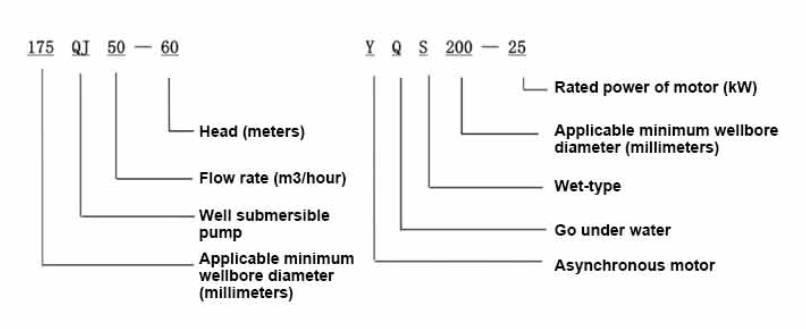
| Modello | Portata (m3/h) | Testa (M) |
Velocità di rotazione (cambiamento/punto) |
Pompa dell'acqua(%) | Presa diametro (mm) |
Applicabile bene diametro (millimetro) |
Valutato power(KW) |
Valutato tensione(V) |
Valutato corrente(A) |
Efficienza motoria (%) | power factorcosφ | Unità Dimensione massima radiale (mm) |
Osservazione | |||||||||
| 250QJ50-40 | 50 | 40 | 2875 | 72 | 80 | 250Sopra | 9.2 | 380 | 21.7 | 78.5 | 0.82 | 233 | ||||||||||
| 250QJ50-60 | 60 | 13 | 30.1 | 80.0 | 0.82 | |||||||||||||||||
| 250QJ50-80 | 80 | 18.5 | 40.8 | 82.0 | 0.84 | |||||||||||||||||
| 250QJ50-100 | 100 | 22 | 47.9 | 83.0 | 0.84 | |||||||||||||||||
| 250QJ50-120 | 120 | 25 | 53.8 | 84.0 | 0.84 | |||||||||||||||||
| 250QJ50-140 | 140 | 30 | 64.2 | 84.5 | 0.84 | |||||||||||||||||
| 250QJ50-160 | 160 | 37 | 77.8 | 85.0 | 0.85 | |||||||||||||||||
| 250QJ50-200 | 200 | 45 | 94.1 | 85.5 | 0.85 | |||||||||||||||||
| 250QJ50-240 | 240 | 55 | 114.3 | 86.0 | 0.85 | |||||||||||||||||
| 250QJ50-280 | 280 | 63 | 131.0 | 86.0 | 0.85 | |||||||||||||||||
| 250QJ50-320 | 320 | 75 | 152.3 | 87.0 | 0.86 | |||||||||||||||||
| 250QJ50-400 | 400 | 90 | 182.8 | 87.0 | 0.86 | |||||||||||||||||
| 250QJ50-440 | 440 | 100 | 203.1 | 87.0 | 0.86 | |||||||||||||||||
| 250QJ63-40 | 63 | 40 | 2875 | 74 | 80 | 250Sopra | 11 | 380 | 25.8 | 79.0 | 0.82 | 233 | ||||||||||
| 250QJ63-60 | 60 | 18.5 | 40.8 | 82.0 | 0.84 | |||||||||||||||||
| 250QJ63-80 | 80 | 22 | 47.9 | 83.0 | 0.84 | |||||||||||||||||
| 250QJ63-100 | 100 | 30 | 64.2 | 84.5 | 0.84 | |||||||||||||||||
| 250QJ63-120 | 120 | 37 | 77.8 | 85.0 | 0.85 | |||||||||||||||||
| 250QJ63-160 | 160 | 45 | 94.1 | 85.5 | 0.85 | |||||||||||||||||
| 250QJ63-200 | 200 | 55 | 114.3 | 86.0 | 0.85 | |||||||||||||||||
| 250QJ63-220 | 220 | 63 | 131.0 | 86.0 | 0.85 | |||||||||||||||||
| 250QJ63-260 | 260 | 75 | 152.3 | 87.0 | 0.86 | |||||||||||||||||
| 250QJ63-300 | 300 | 90 | 182.8 | 87.0 | 0.86 | |||||||||||||||||
| 250QJ63-360 | 360 | 100 | 203.1 | 87.0 | 0.86 | |||||||||||||||||
| 250QJ80-20 | 80 | 20 | 2875 | 75 | 100 | 250Sopra | 7.5 | 380 | 18.0 | 78.0 | 0.81 | 233 | ||||||||||
| 250QJ80-40 | 40 | 15 | 33.9 | 81.0 | 0.83 | |||||||||||||||||
| 250QJ80-60 | 60 | 22 | 47.9 | 83.0 | 0.84 | |||||||||||||||||
| 250QJ80-80 | 80 | 30 | 64.2 | 84.5 | 0.84 | |||||||||||||||||
| 250QJ80-100 | 100 | 37 | 77.8 | 85.0 | 0.85 | |||||||||||||||||
| 250QJ80-120 | 120 | 45 | 94.1 | 85.5 | 0.85 | |||||||||||||||||
| 250QJ80-160 | 80 | 160 | 2875 | 75 | 100 | 250Sopra | 55 | 380 | 114.3 | 86.0 | 0.85 | 233 | ||||||||||
| 250QJ80-180 | 180 | 63 | 131.0 | 86.0 | 0.85 | |||||||||||||||||
| 250QJ80-200 | 200 | 75 | 152.3 | 87.0 | 0.86 | |||||||||||||||||
| 250QJ80-240 | 240 | 90 | 182.8 | 87.0 | 0.86 | |||||||||||||||||
| 250QJ80-280 | 280 | 100 | 203.1 | 87.0 | 0.86 | |||||||||||||||||
| 250QJ100-18 | 100 | 18 | 2875 | 75 | 100 | 250Sopra | 7.5 | 380 | 18.0 | 78.0 | 0.81 | 233 | ||||||||||
| 250QJ100-36 | 36 | 15 | 33.9 | 81.0 | 0.83 | |||||||||||||||||
| 250QJ100-54 | 54 | 25 | 53.8 | 84.0 | 0.84 | |||||||||||||||||
| 250QJ100-72 | 72 | 30 | 64.2 | 84.5 | 0.84 | |||||||||||||||||
| 250QJ100-90 | 90 | 37 | 77.8 | 85.0 | 0.85 | |||||||||||||||||
| 250QJ100-108 | 108 | 45 | 94.1 | 85.5 | 0.85 | |||||||||||||||||
| 250QJ100-126 | 126 | 55 | 114.3 | 86.0 | 0.85 | |||||||||||||||||
| 250QJ100-144 | 144 | 63 | 131.0 | 86.0 | 0.85 | |||||||||||||||||
| 250QJ100-162 | 162 | 75 | 152.3 | 87.0 | 0.86 | |||||||||||||||||
| 250QJ100-198 | 198 | 90 | 182.8 | 87.0 | 0.86 | |||||||||||||||||
| 250QJ100-216 | 216 | 100 | 203.1 | 87.0 | 0.86 | |||||||||||||||||
| 250QJ125-16 | 125 | 16 | 2875 | 76 | 125 | 250Sopra | 9.2 | 380 | 21.7 | 78.5 | 0.82 | 233 | ||||||||||
| 250QJ125-32 | 32 | 18.5 | 40.8 | 82.0 | 0.84 | |||||||||||||||||
| 250QJ125-48 | 48 | 25 | 53.8 | 84.0 | 0.84 | |||||||||||||||||
| 250QJ125-64 | 64 | 37 | 77.8 | 85.0 | 0.85 | |||||||||||||||||
| 250QJ125-80 | 80 | 45 | 94.1 | 85.5 | 0.85 | |||||||||||||||||
| 250QJ125-96 | 96 | 55 | 114.3 | 86.0 | 0.85 | |||||||||||||||||
| 250QJ125-112 | 112 | 63 | 131.0 | 86.0 | 0.85 | |||||||||||||||||
| 250QJ125-128 | 128 | 75 | 152.3 | 87.0 | 0.86 | |||||||||||||||||
| 250QJ125-160 | 160 | 90 | 182.8 | 87.0 | 0.86 | |||||||||||||||||
| 250QJ125-176 | 176 | 100 | 203.1 | 87.0 | 0.86 | |||||||||||||||||
| 250QJ125-192 | 192 | 110 | 219.6 | 87.5 | 0.87 | |||||||||||||||||
| 250QJ140-15 | 140 | 15 | 2875 | 76 | 125 | 250Sopra | 9.2 | 380 | 21.7 | 78.5 | 0.82 | 233 | ||||||||||
| 250QJ140-30 | 30 | 18.5 | 40.8 | 82.0 | 0.84 | |||||||||||||||||
| 250QJ140-45 | 45 | 30 | 64.2 | 84.5 | 0.84 | |||||||||||||||||
| 250QJ140-60 | 60 | 37 | 77.8 | 85.0 | 0.85 | |||||||||||||||||
| 250QJ140-75 | 45 | 45 | 94.1 | 85.5 | 0.85 | |||||||||||||||||
| 250QJ140-90 | 90 | 55 | 114.3 | 86.0 | 0.85 | |||||||||||||||||
| 250QJ140-105 | 140 | 105 | 2875 | 76 | 125 | 250Sopra | 63 | 380 | 131.0 | 86.0 | 0.85 | 233 | ||||||||||
| 250QJ140-120 | 120 | 75 | 152.3 | 87.0 | 0.86 | |||||||||||||||||
| 250QJ140-150 | 150 | 90 | 182.8 | 87.0 | 0.86 | |||||||||||||||||
| 250QJ140-165 | 165 | 100 | 203.1 | 87.0 | 0.86 | |||||||||||||||||
| 250QJ140-180 | 180 | 110 | 219.6 | 87.5 | 0.87 | |||||||||||||||||
| 250QJ200-20 | 200 | 20 | 2875 | 75 | 150 | 250Sopra | 18.5 | 380 | 40.8 | 82.0 | 0.84 | 233 | ||||||||||
| 250QJ200-40 | 40 | 37 | 77.8 | 85.0 | 0.85 | |||||||||||||||||
| 250QJ200-60 | 60 | 55 | 114.3 | 86.0 | 0.85 | |||||||||||||||||
| 250QJ200-80 | 80 | 75 | 152.3 | 87.0 | 0.86 | |||||||||||||||||
| 250QJ200-100 | 100 | 90 | 182.8 | 87.0 | 0.86 | |||||||||||||||||
| 250QJ200-120 | 120 | 100 | 203.1 | 87.0 | 0.86 | |||||||||||||||||
| 250QJ200-140 | 140 | 125 | 249.5 | 87.5 | 0.87 | |||||||||||||||||
1, well submersible pump for clean water pump, prohibit the new well, pumping sediment and muddy water,
2, well water pump voltage grade of 380/50HZ, the use of other voltage grades of submersible motors need to be customized. The underground cable must use waterproof cable, must be equipped with starting equipment, such as distribution box, start not ready should have commonly used motor comprehensive protection function, such as short circuit overload protection, phase protection, undervoltage protection, grounding protection, idling protection, in case of abnormal conditions, the protection device should be timely action trip.
3, the installation and use of the pump must be reliably grounded, prohibit the push and pull switch when the hands and feet are wet, the installation and maintenance of the pump must be cut off the power supply, the use of the pump place to set up "to prevent electric shock" obvious signs:
4, down the well or before installation, the motor cavity must be filled with distilled water or non-corrosive clean cold boiling water, tighten the / water bolt, the pump on the ground test run, must be to the pump chamber water lubrication rubber bearings, instant start not more than a second, see whether the steering is the same as the steering instructions. When the pump is upright, pay attention to safety, prevent overturning injury.
5, rigorosamente secondo le disposizioni dell'ascensore della pompa, del campo di utilizzo del flusso, per evitare che la forza di pompaggio a basso flusso o ad alto sollevamento, il cuscinetto reggispinta e altre parti soggette a usura, il sovraccarico del motore brucino
6, after the pump down the well, the measurement of the motor to the ground insulation resistance should not be less than 100M, after the start to observe the voltage and current, check the motor winding insulation, whether in line with the requirements; pump storage location temperature if less than freezing point, should be dry the motor cavity water, prevent the motor cavity water ice damage caused by low temperature.
The introduction and structure of this pump product mainly include pump shaft, impeller, shunt shell, rubber bearing, check valve body (optional) and other components. The motor part is mainly composed of base, pressure regulating diaphragm, thrust bearing, thrust plate, lower guide bearing seat, stator, rotor, upper guide bearing seat, sand ring, water inlet section, lead cable and other components. The main characteristics of this pump product include the use of water-cooled wet submersible three-phase asynchronous motor, the motor cavity is filled with clean water to cool the motor and lubricate the bearing, the pressure regulating diaphragm at the bottom is used to adjust the expansion and contraction pressure difference of the internal water caused by the change of the temperature rise of the motor. In order to prevent the sand particles in the well water from entering the motor, two oil seals are installed on the upper end of the motor shaft extension, and the sand ring is installed to form a sand prevention structure. In order to avoid the pump shaft jumping at startup, the pump shaft and the motor shaft are connected together through the coupling, and the thrust bearing is installed at the lower part of the motor. The motor and pump bearing lubrication adopts water lubrication. The stator winding of the motor adopts high quality submersible motor winding, with high insulation performance. The pump adopts computer CAD design, simple structure and superior technical performance.

(1)Preparazione prima dell'installazione:
1. Controllare se la pompa sommersa soddisfa le condizioni di utilizzo e l'ambito specificato nel manuale.
2. Utilizzando un oggetto pesante con un diametro pari al diametro esterno massimo della pompa sommergibile, misurare se il diametro interno del pozzo può adattarsi alla pompa sommergibile e misurare se la profondità del pozzo soddisfa i requisiti di installazione.
3. Controllare se il pozzo è pulito e se l'acqua del pozzo è torbida. Non utilizzare mai un'elettropompa sommergibile per lavare la pompa welor dal fango e dall'acqua della sabbia per evitare danni prematuri all'elettropompa sommergibile.
4. Controllare se la posizione del morsetto di installazione della testa pozzo è adatta e se può sopportare la qualità dell'intera unità
5. Controllare se i componenti della pompa sommersa sono completi e installati correttamente secondo lo schema di montaggio nel manuale Rimuovere lo schermo del filtro e ruotare il giunto per vedere se ruota in modo flessibile
6. Svitare la vite dell'acqua e riempire la cavità del motore con acqua pulita e non corrosiva (nota: assicurarsi di riempirla), quindi serrare la vite dell'acqua. Dopo 12 ore di iniezione d'acqua, la resistenza di isolamento del motore non deve essere inferiore a 150 MQ se misurata con una tavola vibrante da 500 V.
7. Cable joint, cut off a 120mm rubber sleeve from one end of the outgoing cable and the matching cable with an electrician's knifethen stagger the length of the three core wires in a stepped shape, peel off a 20mm copper core, scrape of the oxide layer on theoutside of the copper wire with a knife or sand cloth, and insert the two connected wire ends in palirs.After tying the layer tightly with fine copper wire, solder it thoroughly and firmly, and sand of any. burrs on the surface. Then, forthe three joints, use polyvester insulation tape to wrap them in a semi stacked manner for three lavers. Wrap the two ends of thewrapping layer tightywith nyion thread,and then use a semi stacked method to wrap the tape for three layers. Wrap the outellayer with high-pressure insulation tape for three layers. Finally, fold the threestrands together and repeatedly wrap them for fivelayers with high-pressure tape. Each layer must be tightly tied, and the interlayer joints must be tight and fimm to prevent water frompenetrating and damaging the insulation, After wrapping, soak in water at room temperature of 20 ’c for 12 hours, and measurethe insulation resistance with a shaking table, which should not be less than 100M Ω
Lo schema del processo di cablaggio del cavo allegato è il seguente: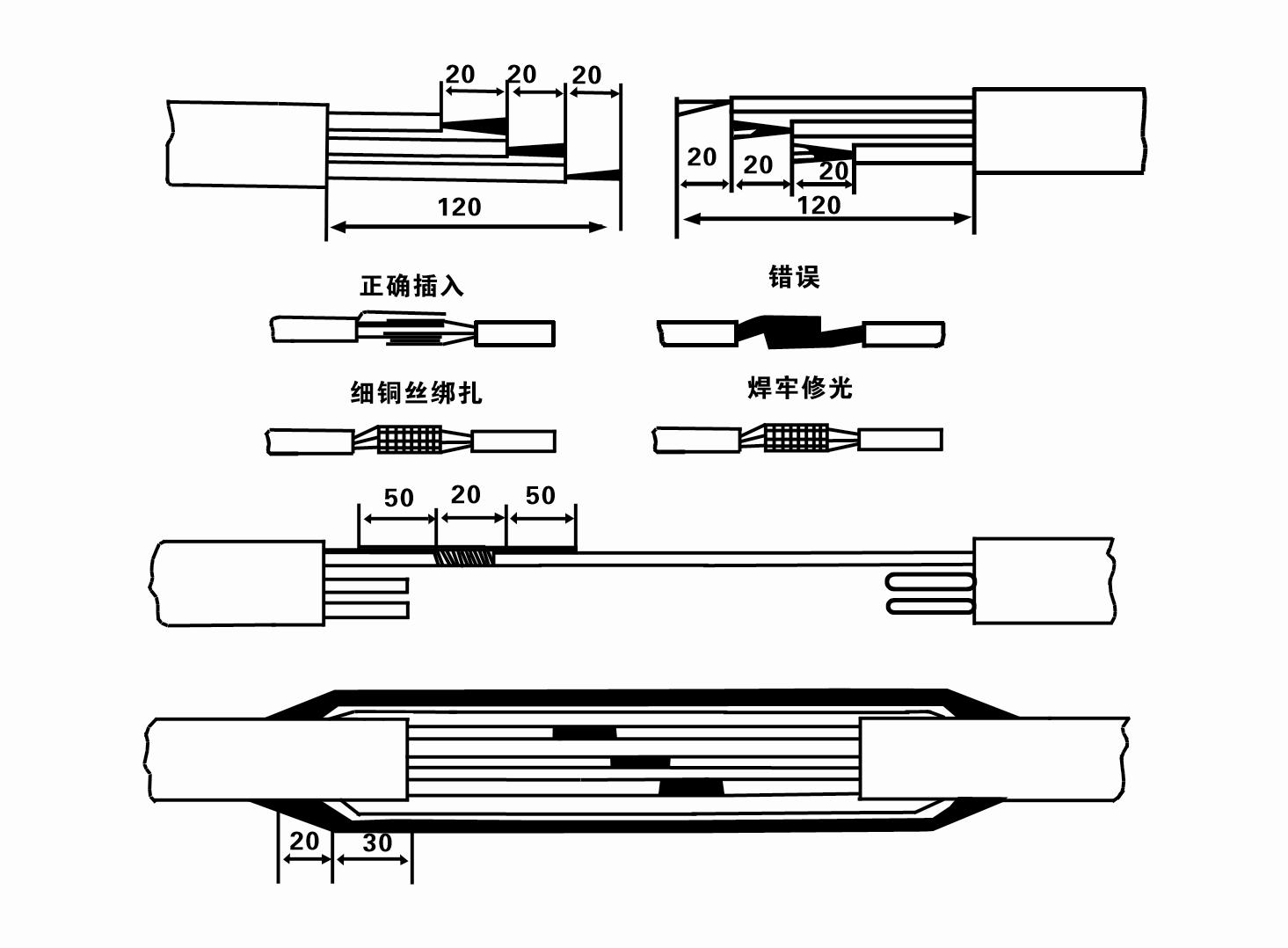
8. Utilizzare un multimetro per verificare se i cavi trifase sono collegati e se la resistenza CC è approssimativamente bilanciata.
9. Controllare se il circuito e la capacità del trasformatore sono sovraccarichi, quindi collegare l'interruttore di protezione da sovraccarico o l'apparecchiatura di avviamento. Vedere la Tabella 2 per i modelli specifici, quindi versare un secchio d'acqua nella pompa dell'acqua dall'uscita della pompa dell'acqua per lubrificare i cuscinetti di gomma nella pompa, quindi posizionare l'elettropompa sommergibile in posizione verticale e stabile. Avvio (non più di un secondo) e controllare se la direzione dello sterzo è coerente con il segnale dello sterzo. In caso contrario, scambia due connettori qualsiasi del cavo trifase. Quindi installa il filtro e preparati a scendere nel pozzo. Se utilizzata in occasioni particolari (come fossi, fossi, fiumi, stagni, stagni, ecc.), l'elettropompa deve essere collegata a terra in modo affidabile.
(2)Attrezzature e strumenti di installazione:
1. Una coppia di catene di sollevamento per più di due tonnellate.
2. Un treppiede con altezza verticale non inferiore a quattro metri.
3. Due funi sospese (funi metalliche) che possono sopportare un peso superiore a una tonnellata (possono sopportare il peso di un set completo di pompe dell'acqua).
4. Installare due paia di morsetti (stecche).
5. Chiavi inglesi, martelli, cacciaviti, utensili e strumenti elettrici, ecc.
(3)Installazione dell'elettropompa:
1. Lo schema di installazione dell'elettropompa sommergibile è mostrato nella Figura 2. Le dimensioni specifiche di installazione sono riportate nella Tabella 3 "Elenco dimensioni di installazione dell'elettropompa sommersa".
2. Le elettropompe sommergibili con una prevalenza inferiore a 30 metri possono essere issate direttamente nel pozzo utilizzando tubi flessibili e funi metalliche o altre funi di canapa in grado di sopportare l'intero peso dell'intera macchina, dei tubi dell'acqua e dell'acqua nei tubi.
3. Le pompe con una prevalenza superiore a 30 metri utilizzano tubi in acciaio e la sequenza di installazione è la seguente:
①Utilizzare un morsetto per bloccare l'estremità superiore della parte della pompa dell'acqua (il motore e la pompa dell'acqua sono stati collegati in questo momento), sollevarla con una catena sospesa e legarla lentamente nel pozzo finché non posizionare il morsetto sulla testa del pozzo e rimuovere il catena sospesa.
② Utilizzare un altro paio di fascette per serrare un tubo, sollevarlo con una catena sospesa a 15 cm di distanza dalla flangia e abbassarlo lentamente. Tra la flangia del tubo e la flangia della pompaMettere il cuscinetto in gomma in posizione e serrare il tubo e la pompa in modo uniforme con bulloni, dadi e rondelle elastiche.
③ Sollevare leggermente la pompa sommergibile, rimuovere il morsetto sull'estremità superiore della pompa dell'acqua, legare saldamente il cavo al tubo dell'acqua con un nastro di plastica e legarlo lentamente finché il morsetto non viene posizionato sulla testa del pozzo.
④Utilizzare lo stesso metodo per collegare tutti i tubi dell'acqua al pozzo.
⑤Dopo aver collegato il cavo di uscita all'interruttore di controllo, è collegato all'alimentazione trifase.
(4) Cose da notare durante l'installazione:
1. Se si riscontra un fenomeno di inceppamento durante il processo di pompaggio, girare o tirare il tubo dell'acqua per superare il punto di inceppamento. Se vari accorgimenti continuano a non funzionare, non forzare la pompa per evitare danni all'elettropompa sommergibile e al pozzo.
2. Durante l'installazione, posizionare un tampone di gomma sulla flangia di ciascun tubo e serrarlo uniformemente.
3. Quando la pompa dell'acqua viene abbassata nel pozzo, deve essere posizionata al centro del tubo del pozzo per evitare che la pompa funzioni a lungo contro la parete del pozzo, provocando vibrazioni della pompa e spazzamento e bruciatura del motore .
4. Determinare la profondità della pompa dell'acqua sul fondo del pozzo in base alle condizioni di scorrimento della sabbia e del limo nel pozzo. Non seppellire la pompa nel fango. La distanza dalla pompa dell'acqua al fondo del pozzo non è generalmente inferiore a 3 metri (vedi Figura 2).
5. La profondità di ingresso dell'acqua della pompa dell'acqua non deve essere inferiore a 1-1,5 metri dal livello dinamico dell'acqua al nodo di ingresso dell'acqua (vedere Figura 2). In caso contrario, i cuscinetti della pompa dell'acqua potrebbero danneggiarsi facilmente.
6. L'alzata della pompa dell'acqua non può essere troppo bassa. Altrimenti, è necessario installare una valvola a saracinesca sulla tubazione dell'acqua della testa del pozzo per controllare il flusso della pompa al punto di flusso nominale per evitare che il motore venga sovraccaricato e bruciato a causa delle grandi portate.
7. Quando la pompa dell'acqua è in funzione, l'uscita dell'acqua dovrebbe essere continua e uniforme, la corrente dovrebbe essere stabile (nelle condizioni di lavoro nominali, generalmente non più del 10% della corrente nominale) e non dovrebbero esserci vibrazioni o rumore. Se si riscontra qualche anomalia, è necessario arrestare la macchina per scoprirne la causa ed eliminarla.
8. Durante l'installazione, prestare attenzione all'impostazione del filo di terra del motore (vedere Figura 2). Quando la tubazione dell'acqua è di acciaio, farla uscire dal morsetto di testa pozzo; quando il tubo dell'acqua è di plastica, collegarlo al punto di messa a terra dell'elettropompa.
After the installation of the underwater pump, the insulation resistance and three-phase continuity of the switch face should be rechecked, and the connection between the instrument and the start device should be checked for any errors. If there is no problem, you can start to test the machine. After the start, observe whether the indication readings of each instrument are correct. If the rated voltage and current specified on the nameplate are exceeded, observe whether the pump has noise or vibration. If everything is normal, it can be put into operation. After the first operation of the pump for four hours, the motor should be shut down and tested for thermal insulation resistance quickly. Its value should not be less than 0.5 megaohm. After stopping the pump, it should be restarted after an interval of five minutes to prevent the water column in the pipeline from completely reversing and causing the motor to burn out due to excessive current. After the pump is put into normal operation, in order to prolong its service life, it is necessary to check regularly whether the supply voltage, running current and insulation resistance are normal. If the following conditions are found, the machine should be shut down immediately to eliminate the fault: the current exceeds 20% under rated working conditions; the dynamic water level drops to the inlet section, resulting in intermittent drainage; the underwater pump becomes violently vibrating or making noise; the supply voltage is lower than 340 volts; a fuse is blown out; the water pipe is damaged; the motor's thermal insulation resistance to the earth is less than 0.5 megaohm. The sequence of disassembly is: untie the cable fastening, remove the pipeline part, remove the line protection plate, screw down the water discharge bolt and discharge all the water in the motor chamber, remove the filter and loosen the coupling fixing screw of the motor shaft. The sequence of disassembly of the pump is: (see Figure 1) inlet section, impeller, guide housing, impeller, check the valve body. When removing the impeller, use special tools to loosen the taper sleeve of the impeller. Avoid bending the pump shaft and damaging the components throughout the process. The disassembly process of the motor is: (see Figure 1) put the motor on the platform, and remove the bolts, base, shaft head lock nut, thrust plate, key, lower guide plate (transverse bolt), bearing seat, screw knife seat from the bottom of the motor in order (take care not to damage the winding), and finally remove the connecting part and the upper guide bearing seat. Before assembling the unit, the rust and dirt of each part should be cleaned, and the sealant should be applied to each mating surface and fastener, and then assembled in reverse order of disassembly (the movement of the motor shaft after assembly is about one millimeter). After assembly, the coupling should be rotated flexibly and put on the filter for test. Once a year, or if less than a year of operation but has been immersed for two years, the underwater electric pump must be disassembled for maintenance in accordance with Article 5 and replace worn parts to ensure the normal operation and durability of the pump.
1, far uscire l'acqua nella cavità del motore (soprattutto in inverno per evitare il congelamento del motore) e legare bene il cavo.
2, store in an indoor room without corrosive substances and gases, with a temperature below 40 °C.
3, l'uso a lungo termine dovrebbe prestare attenzione alla prevenzione della ruggine delle pompe sommergibili.
- Girante
- Manicotto dell'albero
- Manicotto dell'albero in gomma
-
Anello di tenuta
01 Presa d'acqua da pozzo profondo
02 Approvvigionamento idrico a molti piani
03 approvvigionamento idrico di montagna
04 torre d'acqua
05 Irrigazione agricola
06 irrigazione del giardino
07 presa d'acqua del fiume
08 acqua sanitaria

